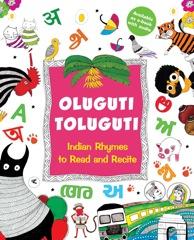
Edited by Radhika Menon and Sandhya Rao, Oluguti Toluguti is a compilation of Indian Rhymes to read and recite; the book has colourful illustrations, very child appropriate, and many, many ideas that children will relate to.
The development of language in very young children begins with the acquisition of sounds and the rhythm of a language. As a matter of fact it is the rhythm that catches the attention of a child. From this anchor he goes on to put the sounds together and utter words.
However the most important engagement of any child’s mind is to make sense of the world. It is here that rhymes arrests his attention what with the rhythm as well. If so it makes sense to think that the child will be able to relate to his immediate surroundings as well as the culture that he is surrounded by. In a desperate aspiration to feel assured that the child’s learning abilities are well in place many a parent teaches the child English rhymes which are naturally set in the milieu of the country of origin. It is here that Olugutti Tolugutti plays a vital role. This compilation of rhymes which covers 54 rhymes in 18 different Indian languages with English translations is a wonderful piece of work which introduces this coveted format of rhymes to very young children while retaining the culture of India.
Post colonisation, language, in India is being perceived as a mere goal to the world of academics and employment. English sits high on this language pyramid. It has not been addressed from the role it plays in social acceptance not only of the language itself but of the people to whom a particular Language is the vernacular. In other words a sense of hierarchy is attributed to a language and this position is reflected by and towards the people relating to the language as well. The first and foundational step in the acceptance of a language is to have listened to it at an age when we suspend judgement and enjoy the rhythm and play of sounds of the language. The best way and age to do this is to engage in the rhymes with the intonation that accompanies it, at an early age when it is a joy to articulate different sounds.
In a country like India which is multilingual it is important that children are exposed to the sounds of the different languages so that they are able to accept the language and its people with abroad minded perspective.
The book also contains the script of the original language which is fascinating to a young mind.
I have many favourites in this book, and have engaged with it in a class of 4 year olds who loves the sounds, scripts and the recitation as well. The Punjabi, Urdu, the Malayalam and so on.
I do believe it is a must for any family who have little kids at home and would like to celebrate the diversity of this country, as well the rich heritage that this book offers.
A veritable treasure!